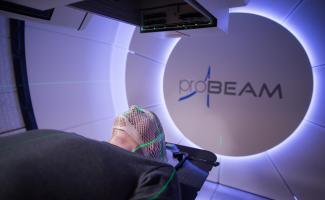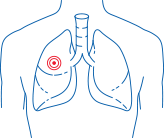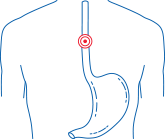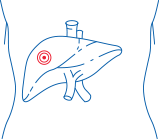Proton therapy
ProBeam proton therapy system
Construction of the Proton therapy center of Dr. Berezin Medical Institute (MIBS) began in 2012, today, proton radiation therapy is the most precise, safe and sparing cancer treatment method. After completion of the construction, start-up and final tune-in of the equipment, now the center works in a full operating mode.
The ProBeam superconducting cyclotron has several advantages over a conventional cyclotron:
- Compact design, less weight.
- High efficiency of creation of a beam of accelerated particles and accordingly - high radiation dose rate.
- Maximum automation of the treatment process.
- Less energy consumption
The ProBeam superconducting cyclotron
A special design feature of the Varian ProBeam® system is the use of an isochronous cyclotron with superconducting electromagnets (the so-called superconducting cyclotron). Its energy capabilities allow delivery of radiation doses to tumors lying at a depth of 4-30 cm providing the widest range of energy for treatment without the use of range switches.
The additional features of ProBeam cyclotron are as follows:
- There is no need for a warm-up phase, since the cyclotron operates continuously in the maximum efficiency mode.
- A beam of charged particles is produced continuously.
- Beam intensity is adjustable.
- A pillbox design with an automatic top pole lifting system increases the ease of maintenance.
- A compact internal ionization source reduces the cost of the equipment.
- Compact footprint reduces installation costs.
- No need for high-energy electromagnets, the installation of which requires the removal of heat.
- Guaranteed performance.
Functionality of the superconducting cyclotron
Superconducting electromagnets of an isochronous cyclotron provides high efficiency in producing a beam of charged particles, low power consumption, excellent reliability and reduced operating costs. In contrast to other installations, the Varian isochronous accelerator operates in a very predictable manner. Processes are automated as much as possible there is no need to configure the cyclotron by the operator.
The isochronous cyclotron performs proton therapy treatments with modulated intensity
The Varian isochronous cyclotron has compact dimensions and high thermal stability that it became the first isochronous cyclotron available on the market with superconducting electromagnets for medical use since 2007. A continuous and stable proton beam is able to perform proton therapy with modulated intensity in a shorter time and with a more conformal dose than when delivered by passive scattering (although passive scattering is now used in most proton therapy centers).
The type of proton delivery: pencil beam scanning or passive scattering
The choice of the type of dose delivery is an important point for the treatment of the disease. Passive scattering is proton therapy of the previous generation, a technique used by most of the long-operating centers. To date, pencil beam scanning is a more accurate type of proton therapy and most new proton centers choose it.
- Our center uses
- the pencil beam scanning technology
- Why is pencil beam scanning technology the best?
- Passive scattering
With passive scattering the proton beam is formed in accordance with the outlines of the tumor by installing a scattering material in its path. It is necessary to consider the following features when using the passive scattering method:
- To deliver the conformal dose to the target, this technology uses beam forming devices that are manufactured either by the Center itself or purchased from suppliers.
- Patients need to wait for the manufacture of such devices.
- The beam-forming devices become radioactive during the treatment and must be stored for months after use (for which the center requires a specially allocated place).
- When the scattered beam of protons contacts the scattering material or beam forming device, it creates neutrons - secondary radiation.
- Secondary radiation irradiates a healthy tissue located near the target.
- When protons collide with a scattering material and beam forming devices, they lose energy or narrow the range of irradiation action necessary to treat the patient.
- With passive scattering it is more difficult to achieve the delivery of the optimal dose to the target.
- Although passive dispersal may be more preferable over conventional radiotherapy, it does not provide the maximum effect that the modulated intensity proton therapy provides. The greatest effect from irradiation with protons is provided only by pencil beam scanning.
Pencil beam scanning
Pencil beam scanning (PBS) or scanning with a sharply pointed beam is the advanced method in using protons for the treatment of cancer, which is used so far in just a few proton centers of the world.
The team of the MIBS Proton Therapy Center has mastered the PBS technology.
The "pencil" beam scanning technology is based on complex treatment planning systems and multiple magnets, which direct a narrow proton beam effectively "painting" the dose of radiation layer by layer. A highly targeted beam of protons moves along the vertical and horizontal axes, like the tip of a pencil "painting" the entire tumor. In the process of beam movement, its intensity is modulated. Radiation of the maximum permissible intensity is delivered exactly to cancer cells avoiding normal tissues.
Pencil beam scanning is very effective in the treatment of the most complex oncopathologies, such as prostate, brain, eye, cancer in children. Proton therapy with modulated intensity is the most suitable for delivering a powerful and accurate dose of protons to complex or concave tumors that may be near the spine or inside the head, neck or skull base.
Pencil beam scanning versus passive scattering
| Compared parameters | Pencil beam scanning | Passive scattering |
|---|---|---|
| Provides the most effective proton therapy with modulated intensity | Yes | No |
| Custom-made special compensators and collimators are required for each specific patient | No | Yes |
| These devices may require more time to prepare for each treatment | No | Yes |
| These devices can increase the total cost of treatment | No | Yes |
| Proton centers may need special places to store these radioactive components | No | Yes |
| Collision of protons with beam forming devices creates secondary radiation | Only when using the particle range switch | Much stronger secondary radiation, since the devices are used for all treatment sessions |
| Control over the loss of energy | Controlled energy loss when using particle range switches | Uncontrolled loss of energy due to the use of beam forming devices |
| Duration of treatments | The duration of treatment with the beam switched on can take only a couple of minutes | The beam itself takes only a couple of minutes to switch on but it takes more time to prepare for each treatment due to the use of compensators and collimators |
| Treatment area | Wider area than with scattering | Smaller area than with pencil beam scanning |
| Dose delivery accuracy | The dose is delivered directly to the tumor with less impact on surrounding tissue. This is especially important in the treatment of children or when the tumor is located close to a critical structure | The dose is delivered to the tumor with a more notable effect on the surrounding tissue |
| Beam penetration | More accurate scanning, which helps to treat deep- seated and or complex tumors | Less accurate scanning |
| The year when the technology was adopted for treating patients | 2007 | 1980s |
| The equipment was selected by the majority of centers in the last 3 years | Yes | No |
HEAD AND NECK CANCER
Proton therapy can effectively treat complex head and neck tumors while at the same time minimizing the dose of radiation for such vital organs as the eyes, mouth and brain. Due to this, the most important physical functions - vision, smell, taste and swallowing - remain unaffected when the patient undergoes a course of treatment. Proton therapy is indicated for cancers of the following locations:- nasal and sinus cavities
- oral cavity, including salivary glands, tongue and amygdala
- larynx
- eyes
- base of skull
- spinal cord
Proton therapy with modulated intensity or a pencil beam scan can easily indicate head and neck cancer.This advanced technology used in some proton centers in the world, including - in the MIBS center. The technology of "pencil" scanning is based on complex treatment planning systems and multiple magnets, which direct a narrow proton beam, effectively, "painting" the dose of radiation layer by layer. A highly targeted beam of protons moves along the vertical and horizontal axes, like the tip of a pencil "painting" the entire tumor, in this process of beam movement its intensity is modulated.
Radiation of the maximum permissible intensity is delivered exactly into cancer cells, while sparing the healthy tissues of important organs located in critical proximity to the pathology zone.
As a result of the treatment of head and neck oncology, standard methods of radiotherapy in 60% of patients require the introduction of a feeding tube.
Proton therapy with modulated intensity makes it possible to avoid this because of less damage to the oral cavity. This therapy also reduces side effects, such as nausea, damage to the salivary glands, loss of taste or endocrine disorders. Patients are able for a better maintain of their weight and water balance in the body, contributes to a favorable outcome of treatment and significantly improves the quality of life during and after cancer treatment.
Procedures usually take from 15 to 30 minutes every day and are held five times a week. The course lasts from 4 to 7 weeks and in some cases, one or more procedures are sufficient. Hospitalization is not required, as most patients tolerate proton therapy are exceptionally well, continue to work and exercise during and immediately after treatment.
PROSTATE CANCER
Prostate or prostatic gland cancer is the second cause of death among men with oncology, but with the early detection of this oncopathology, the five-year survival rate is 99%.Prostate cancer occurs when prostate gland cells expand and multiply uncontrollably, thereby damaging surrounding tissues and interfering with normal organ function. In the next stages, cancer cells can capture other parts of the body.
In early stages of the disease surgery and radiotherapy give approximately the same results. But radiation therapy is the best method of treatment of locally advanced prostate cancer. With larger or more aggressive tumors, radiation therapy can be used in combination with hormonal therapy.
In the MIBS we propose the treatment of prostate cancer by the most advanced method of particles medicine-proton therapy, which has a number of undeniable advantages over conventional radiation therapy:
- precise and accurate delivery of higher radiation doses to cancer cells in the prostate.
- minimal impact on surrounding healthy tissues and vital organs such as the bladder and rectum.
- less invasive (traumatic) process - treatment is painless and allows to continue ordinary life.
- hospitalization is not required, therapy is performed on an outpatient basis.
Pencil beam scanning
Patients who have approached the MIBS proton therapy center can undergo treatment with a pencil beam scanning method, which is a more advanced type of proton therapy (PBS).
In "pencil" scanning, a proton beam whose diameter can be less than one millimeter is guided by numerous magnets to the exact area of the lesion, releasing radiation layer after layer, just as an artist applies the paint with a brush. The advantage of the method is the ability of the beam to enter the tumor at different angles, bypassing the important organs located next to it.Using rapidly emitted pulses, a sharply targeted beam hits each planned point with a given amount of radiation, starting from the farther layer and moving successively, layer by layer until the entire tumor is covered. Usually during one procedure it is required to deliver doses in 1000 - 2000 points located approximately in 20 - 30 layers. Such layer-by-layer scanning "covers" the entire tumor with proton radiation, allowing to target neoplasms having irregular shapes or inhomogeneous depth.
How does the treatment proceed?
When treating prostate cancer with proton therapy, procedures usually take only 15 to 20 minutes per day and are conducted five days a week for approximately two months. After the end of treatment, recovery time is practically not required. The risk of impotence after treatment is minimal, especially for patients who have had a good sexual function before the start of therapy. Most patients exceptionally well tolerate the treatment and are able to continue to work, exercise and remain sexually active during and immediately after treatment.During "pencil" scanning, a proton beam whose diameter can be less than one millimeter, is guided by numerous magnets to the exact area of the lesion, releasing radiation layer by layer, just as the artist paints the paint with a brush. The advantage of the method is the ability of the beam to enter the tumor at different angles, bypassing the important organs located next to it.
LUNG CANCER
Lung cancer is one of the main causes of death of patients with oncopathology. The five-year survival rate is only 15% among those who have been diagnosed with this disease.Approximately 15-20% of patients diagnosed with lung cancer have tumors that can be cured by surgery in combination with radiation therapy. Another 30-50% patients have neoplasms, which require a combined treatment regimen which includes surgery, chemotherapy and radiotherapy. But the location of the lungs in close proximity to important organs makes it difficult to deliver the required dose of radiation to cancer cells without the risk of injuring normal tissues.
Advantages of proton therapy over conventional radiation therapy make it an optimal treatment for many patients with lung cancer. Advanced imaging technologies and the ability to accurately target cancer cells allow our specialists to deliver powerful doses of radiation as accurately as possible without affecting the nearby organs: esophagus, heart and spine. Thanks to this, it becomes possible to irradiate the tumor with a higher dose of radiation, to cope with the disease more quickly and to improve the patient's quality of life.
The problem of irradiation of a tumor site in the lung consists in fluctuations in the geometry of the affected area that arise from the constant anatomical changes and respiratory movements of the patient. Our specialists have mastered ways to effectively fight lung cancer such as treating patients with "synchronized breathing" or breathing delay technique. This allows you to accurately deliver radiation doses directly into cancer cells.
Pencil beam scanning
In addition to the technique of synchronized breathing, the MIBS proton therapy center can offer patients with lung cancer an even more advanced method of treatment - pencil beam scanning (PBS).
During "pencil" scanning, a proton beam whose diameter can be less than one millimeter is guided by numerous magnets to the exact area of the lesion, releasing radiation layer after layer, just as an artist applies the paint with a brush. The advantage of the method is the ability of the beam to enter the tumor at different angles, bypassing the important organs located next to it.
This technology is more accurate and allows to deliver higher doses of radiation to the affected cells. Treatment sessions take less time, decrease in side effects and the variability of treatment increases.
Proton therapy with pencil beam scanning can be used for patients with recurrence of lung cancer who have already received high doses of radiation. In this case a narrow beam restricts or completely eliminates the overspill of radiation into sensitive areas.
How does the treatment proceed?
Procedures usually take from 15 to 30 minutes every day and are held five times a week. The course lasts from 4 to 7 weeks. Hospitalization is not required and most patients are exceptionally well, can continue to work and exercise during and immediately after treatment.ESOPHAGUS CANCER
The number of cases of diagnosing esophageal cancer in the world is growing.The average level of five-year survival in this oncopathology is low, from 10 to 30%.
The treatment of esophageal cancer by standard methods of radiation therapy can be a difficult task due to the proximity of the esophagus to critical organs such as the heart, lungs and spine. Proton therapy can be an optimal choice as it releases a large doses of radiation directly into the tumor site without affecting healthy tissues along the way.
Procedures for treating esophageal cancer usually take 15-30 minutes a day and are done five times a week for approximately 4 to 7 weeks. The duration of the course of treatment depends on the individual case of the disease and the general health of each patient. Many patients tolerate treatment extremely well and can continue to work and exercise during the course of treatment and immediately after it.
LIVER CANCER
Lymphoma is a type of cancer that occurs in the human lymphatic system and is classified either as a Hodgkin's disease or as non-Hodgkin's lymphoma. Since lymph nodes are located in different places of the human body, lymphoma can have any localization.Usually lymphoma is treated with chemotherapy followed by radiotherapy. But often oncological pathologies of this type occur in the chest next to important organs, such as the heart, lungs or esophagus. This makes it difficult to deliver high doses of radiation to the tumor without the risk of damage to these sensitive areas.
Proton therapy provides a chance for recovery of patients with lymphomas that are inoperable due to their localization. Our team of oncologists is able to create a treatment plan in which radiation will accurately affect the most inaccessible tumors while at the same time sparing healthy tissues and not affecting vital organs.
There are reverse cases likely tumors of some patients are resistant to chemotherapy while radiation therapy is the only possible method of treatment, but a high dose of radiation exposure is required to kill cancer cells. With the use of standard radiation therapy, the consequence can be a negative effect on healthy tissue, especially dangerous in cases where the neoplasm is located in close proximity to vital organs. Proton therapy in which a targeted proton beam delivers energy directly to cancer cells without affecting normal tissues and gives a chance for recovery to patients with chemotherapy-resistant lymphomas.
Treatment sessions usually take from 15 to 30 minutes per day and are held five times a week for approximately 4 to 7 weeks. The course of treatment and the duration of the procedure each day varies depending on the individual case of each patient. Most patients tolerate treatment exceptionally well and can continue to work and exercise during the course of treatment and immediately after it.
SARCOMA
Sarcomas are a rare type of malignant tumors. They occur anywhere in the body in both adults and children. The most common method of treating soft tissue sarcoma is surgery. Radiation therapy is rarely used separately more often in addition to surgery. But it can be used for patients to whom surgery is not indicated for health reasons. Or as a palliative treatment - to relieve pain and other symptoms of the disease.Proton therapy is also most often used in combination with other methods. Advantages such as the accuracy of the proton beam targeting of cancer cells, sparing of surrounding healthy tissues and minimal side effects from irradiation, give grounds to consider this method as promising in the treatment of sarcomas in children.
PHOTO AND VIDEOS










Chat with us ![]()

Abu Dhabi, UAE






